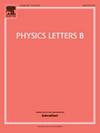Disentangling effects of nucleon size and nucleus structure in relativistic heavy-ion collisions
IF 4.3
2区 物理与天体物理
Q1 ASTRONOMY & ASTROPHYSICS
引用次数: 0
Abstract
While relativistic heavy-ion collisions become an alternative way of studying nucleus structure, the accurate extraction of nucleus structure could be hampered by the uncertainty of nucleon size, and the latter has attracted people's attention in the past few years. We have compared the impacts of nuclear size and nucleus structure on deformation probes in relativistic heavy-ion collisions based on a multiphase transport (AMPT) model. With increasing nucleon size, the absolute values of the deformation probes are generally reduced due to smeared initial density fluctuations. In heavy systems such as 197Au+197Au collisions, neglecting the nucleon size could underestimate or overestimate significantly the extracted deformation parameter depending on the used deformation probe, while the scaled anisotropic flow and the scaled Pearson correlation coefficient of flow and transverse momentum are good probes of the nucleus deformation rather insensitive to the nucleon size. In small systems such as 16O+16O collisions, the deformation probes are generally more sensitive to the nucleon size than to the nucleus structure, and the transverse momentum fluctuation less sensitive to detailed nucleus structure may serve as a good probe of the nucleon size.
相对论性重离子碰撞中核子大小和核结构的解纠缠效应
虽然相对论重离子碰撞成为研究原子核结构的另一种方法,但原子核大小的不确定性阻碍了原子核结构的准确提取,后者在过去几年引起了人们的关注。基于多相输运(AMPT)模型,比较了相对论重离子碰撞中核尺寸和核结构对形变探针的影响。随着核子尺寸的增大,由于初始密度波动的模糊,变形探针的绝对值一般会减小。在197Au+197Au碰撞等重体系中,忽略核子尺寸可能会显著低估或高估所提取的变形参数,这取决于所使用的变形探针,而缩放后的各向异性流动和缩放后的流动和横向动量的Pearson相关系数是核变形的良好探针,而对核子尺寸不敏感。在像16O+16O碰撞这样的小系统中,形变探针对核子尺寸的敏感性通常高于对核子结构的敏感性,而对详细的核子结构不太敏感的横向动量波动可以作为核子尺寸的良好探针。
本文章由计算机程序翻译,如有差异,请以英文原文为准。
求助全文
约1分钟内获得全文
求助全文
来源期刊

Physics Letters B
物理-物理:综合
CiteScore
9.10
自引率
6.80%
发文量
647
审稿时长
3 months
期刊介绍:
Physics Letters B ensures the rapid publication of important new results in particle physics, nuclear physics and cosmology. Specialized editors are responsible for contributions in experimental nuclear physics, theoretical nuclear physics, experimental high-energy physics, theoretical high-energy physics, and astrophysics.
 求助内容:
求助内容: 应助结果提醒方式:
应助结果提醒方式:


